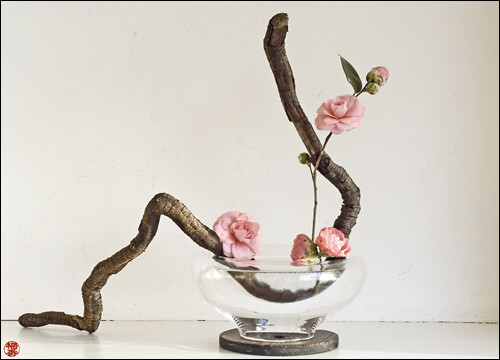
Ikebana is the Japanese art of flower arrangement. Ikebana is a more disciplined form of art that brings together humanity and nature. The normal floral arrangement is intended to bring together multicolored arrangements, whereas ikebana emphasizes other parts of the flowers, particularly the stems and leaves. It draws more emphasis to the form, line, and shape of the flowers being used.
The intention of the artist is seen in the arrangement: the combinations of color, shapes, and lines. Ikebana also emphasizes minimalism in the arrangement. It could be just a few blooms, but many more stems and leaves. Normally, they are arranged between three points or twigs that represent either heaven, earth, and man or sun, earth, and moon. The container is another large part of ikebana, thus a lot of different pottery is used.
Ikebana dates back to the sixth century when Buddhism became widely practiced throughout Japan. Offering Buddha flowers at the altar was widely practiced, and ikebana evolved from this ritual. Classical styles of Ikebana started appearing around the mid-fifteenth century, and the first teachers and students of the art were usually Buddhist priests and practitioners of Buddhism. Throughout time, the style and schools have changed but Ikebana has remained a facet of Japanese culture.
Rules and Principles of Ikebana
Women who practice ikebana generally do so as a form of self-improvement or refinement. However, both men and women can follow it as a spiritual pursuit. Ikebana incorporates a lot of different principles involved with Japanese life. Some of these principles include simplicity, symbolic aesthetics, and an all natural approach to well being.
The aesthetics of the room and the pottery used for each different arrangement matters just as much as the floral arrangement itself. A lot of times, the arrangement might seem very plain and boring. However, the arrangements have aesthetic and spiritual values that have continuously been refined over the centuries.
The flowers, leaves, twigs, and branches are carefully put into place based on the artist`s idea of the intended outcome. The individual symbolism of the arrangement is also kept in mind with every piece put into the arrangement. Form and color of the arrangement are some of the largest considerations, so artists might take a lot of time going through different materials to find exactly what they are in search of. Minimalism and symbolism are key to ikebana.
Historic Styles of Ikebana
The patterns and styles of Ikebana evolved in such a way that by the late 15th century these arrangements were enjoyed not only by the imperial family and their retainers but also by common citizens. The first form of Ikebana was known as Kuge, where only a few flower stems and evergreen branches were used. Ikebana then evolved into a more complex art form with its own set of rules and instructions. Occasionally, there were festivals held to show off this art form. A lot of the examples had a tall, upright stem in the middle of the arrangement accompanied by two smaller stems on either side. In the early 1600’s, castles were constructed using these arrangements.
The Rikka style developed as an expression of the beauty of nature. There are seven branches in total that represent valleys, waterfalls, hills, and other natural objects, all arranged in a beautiful way. Chabana emerged specifically for tea rooms. It emphasized rustic simplicity and helped make way for the next style to develop which was Nageire. This style is non-structured; it has a tight bundle of sticks to form a classical triangle arrangement. This led to Shoka, which uses only three different branches that represent heaven, earth, and human and used to show the uniqueness and beauty of the individual plant.
Contemporary Styles of Ikebana
In the 20th century, a looser, more freestyle became popular in ikebana because of modernism. The upright choice of Moribana is a basic floral structure; it means “piled up flowers”, which it literally is. They are secured in a basket or vase using needlepoint holders or metal frogs. The “slanting” style of Moribana is reversed. All of the materials in the arrangement are slanted, giving them a softer, more beautiful look. The upright style of Nageire is arranged in a tall, narrow container without using any needlepoint holders to hold the arrangement. It can be just one flower, or a many thrown in together. The slanted style of Nageire is gentle and flexible, best suited for beginners of the art form.
Ikebana, although modernized, has a special place in Japanese culture. It provides simplicity as well as natural beauty. Since the stems and flowers in the arrangements each have a specific meaning, this makes ikebana a unique form of floral arrangement. Since Japanese culture is constantly evolving, ikebana is as well.
Ikebana is one of the most beautiful floral arranging techniques. Its simple beauty gives meaning to an otherwise dull floral arrangement. It history gives us all an in-depth look into an art form`s place in Japanese culture.